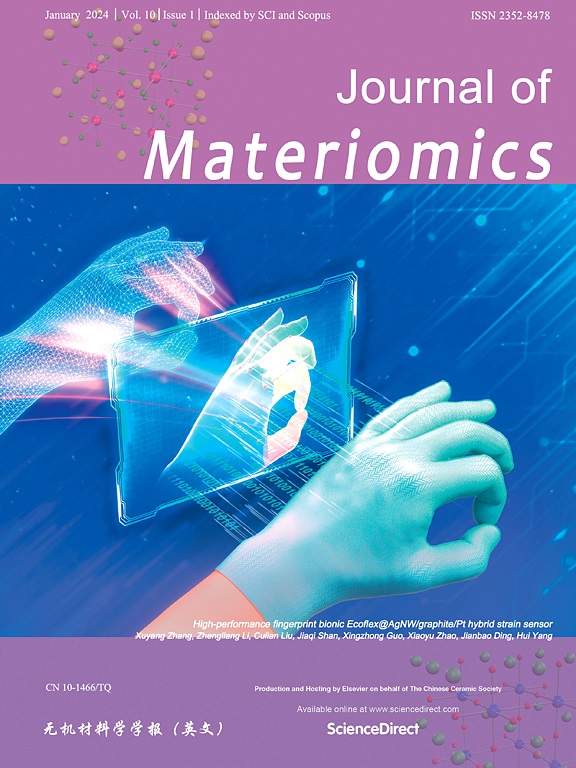用于神经形态计算和安全加密的纳米支架Ba0.6Sr0.4TiO3:Nd2O3铁电忆阻器交叉栅阵列
IF 9.6
1区 材料科学
Q1 CHEMISTRY, PHYSICAL
引用次数: 0
摘要
人工智能的最新进展激发了人们对用于神经形态芯片的铁电记忆电阻器的兴趣,因为它们能够通过极化触发器精确控制电阻状态,而无需电铸。然而,这些器件中的氧空位经常导致高泄漏电流,低耐用性和分散的开关电压。在这里,我们介绍了一种硅基集成(Ba0.6Sr0.4TiO3)0.5(Nd2O3)0.5 (BSTN)纳米包覆铁电薄膜忆阻器,其垂直自组装纳米复合结构(VSNs)最佳定向在La0.67Sr0.33MnO3/SrTiO3/ P-Si衬底上。该器件具有宽可调的铁电畴范围(0°-180°),高残余极化(21.04 μC/cm2)和更多的单态(16个状态或4位)。它具有高耐久性,可承受超过109个开关循环。该开关机制结合了铁电极化和氧空位迁移,通过双向电导可调性模拟生物突触功能。此外,我们使用16×16 BSTN忆阻交叉棒阵列和压力传感器为智能锁实现了低功耗(每事件0.57 pJ)多因素安全加密系统。在多种因素(无序输入、特定用户、对应密码)下,经过500次迭代,系统识别密码的准确率为97.6%,损失率为3.8%。总的来说,这项工作为推进多层次存储、神经形态计算和基于铁电忆阻器的人工智能芯片应用奠定了坚实的基础。本文章由计算机程序翻译,如有差异,请以英文原文为准。


Nanoscaffold Ba0.6Sr0.4TiO3:Nd2O3 ferroelectric memristors crossbar array for neuromorphic computing and secure encryption
Recent advancements in AI have spurred interest in ferroelectric memristors for neuromorphic chips due to their ability to precisely control resistive states through polarization flip-flop without electroforming. However, oxygen vacancies in these devices often cause high leakage current, low endurance, and dispersed switching voltages. Here, we introduce a silicon-based integrated (Ba0.6Sr0.4TiO3)0.5(Nd2O3)0.5 (BSTN) nanoscaffolded ferroelectric thin film memristor with a vertically self-assembled nanocomposite structure (VSNs) optimally oriented on La0.67Sr0.33MnO3/SrTiO3/P![]() Si substrates. This device demonstrates a widely tunable ferroelectric domain range (0°–180°), high remnant polarization (21.04 μC/cm2), and a greater number of unitary states (16 states or 4 bits). It exhibits high durability, enduring over 109 switching cycles. The switching mechanism combines ferroelectric polarization and oxygen vacancy migration, enabling the simulation of biological synaptic functions via bi-directional conductance tunability. Additionally, we implemented a low-power (0.57 pJ per event) multi-factor secure encryption system for smart locks using 16×16 BSTN memristor crossbar arrays and a pressure sensor. Under multiple factors (disordered inputs, specific users, and corresponding passwords) the system recognized passwords with 97.6% accuracy and a 3.8% loss rate after 500 iterations. Overall, this work establishes a robust foundation for advancing multilevel storage, neuromorphic computing, and AI chip applications based on ferroelectric memristors.
Si substrates. This device demonstrates a widely tunable ferroelectric domain range (0°–180°), high remnant polarization (21.04 μC/cm2), and a greater number of unitary states (16 states or 4 bits). It exhibits high durability, enduring over 109 switching cycles. The switching mechanism combines ferroelectric polarization and oxygen vacancy migration, enabling the simulation of biological synaptic functions via bi-directional conductance tunability. Additionally, we implemented a low-power (0.57 pJ per event) multi-factor secure encryption system for smart locks using 16×16 BSTN memristor crossbar arrays and a pressure sensor. Under multiple factors (disordered inputs, specific users, and corresponding passwords) the system recognized passwords with 97.6% accuracy and a 3.8% loss rate after 500 iterations. Overall, this work establishes a robust foundation for advancing multilevel storage, neuromorphic computing, and AI chip applications based on ferroelectric memristors.
求助全文
通过发布文献求助,成功后即可免费获取论文全文。
去求助
来源期刊

Journal of Materiomics
Materials Science-Metals and Alloys
CiteScore
14.30
自引率
6.40%
发文量
331
审稿时长
37 days
期刊介绍:
The Journal of Materiomics is a peer-reviewed open-access journal that aims to serve as a forum for the continuous dissemination of research within the field of materials science. It particularly emphasizes systematic studies on the relationships between composition, processing, structure, property, and performance of advanced materials. The journal is supported by the Chinese Ceramic Society and is indexed in SCIE and Scopus. It is commonly referred to as J Materiomics.
 求助内容:
求助内容: 应助结果提醒方式:
应助结果提醒方式:


